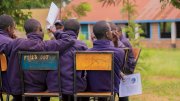1924 The Bulletin's editors report themselves glad "to record that John Harvard has at last come into his own"the University authorities have moved his statue from the Delta next to Memorial Hall (a post "of doubtful prominence"), to the west side of University Hall.
1929 The Faculty of Arts and Sciences has set French and German on a par with Latin by accepting an advanced entrance examination in either modern language toward College admission.
|
1934 The editors note that the residential Houses do not yet have distinguishing academic or social characteristics, yet all but Kirkland have acquired new names among, and for, their undergraduates: "Gold Coasters" (Adams); "Pioneers" (Dunster); "Elephants" (Eliot); "Rabbits" (Leverett); "Bell Boys" (Lowell); "the Puritans" (Winthrop).
1944 An unofficial victory garden of radishes has sprouted amid the new grass in the area immediately in front of John Harvard's statue.
1949 The Faculty of Arts and Sciences agrees to a three-year trial for a junior-year-abroad program for concentrators in Romance and Germanic languages and literatures.
1954 Harvard alumnae attending Commencement receive red ribbon badges to distinguish them from women guests. Harvard Alumni Association president John Cowles '21 notes that "More than 1,800 women now hold Harvard degrees...I am happy [to be president] during the year when it finally recognized the fact that women are people, even at Harvard."
1959 The Business School"the last bastion" among graduate schoolsagrees to admit qualified women as degree candidates, starting in the fall.
1969 A committee of four faculty members and two students recommends unanimously that at the end of a two-year phasing-out period, the ROTC program at Harvard be terminated.
1979 The first generation of Core Curriculum courses is announced: the 55 new offerings in six fields have passed unusually strict faculty guidelines on content, and at least 20 proposals have been turned down.






